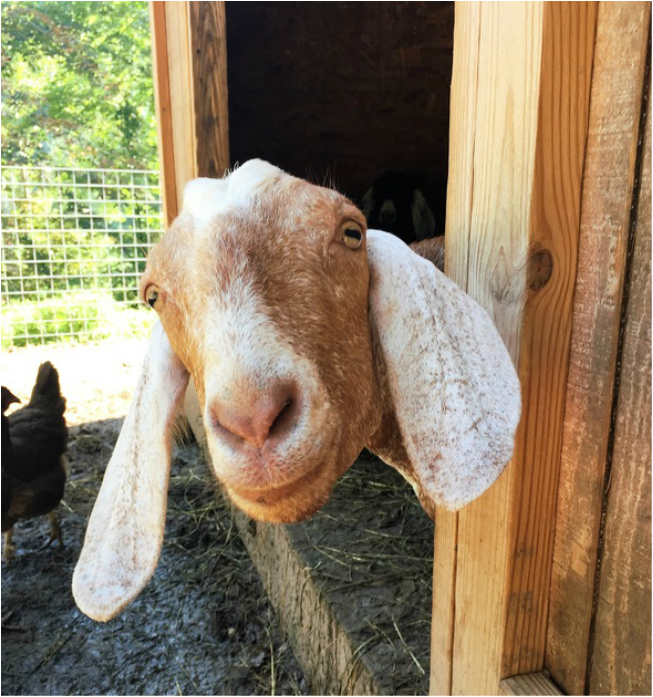|
Anyone who says raising goats is easy has never had a goat. After nearly four years of raising dairy goats, I've learned so much, but realize frequently I still have a lot to learn. Like raising all livestock and even pets, there is worry and heartache, but the joy and love they give makes it all worthwhile.
Ember is my full blooded Nubian, a beautiful and sweet girl full of grace and personality. She has been an excellent teacher to this budding goat lady, and provided enough milk for us to drink, make cheese and soap, and keep the cats fat. To say she is an 'easy keeper' would be an oxymoron. This year has been a hard one for her. First, she was pregnant with triplets, and toward the end of her pregnancy developed ketosis. Her metabolic needs exceeded her ability to take in enough food to meet them. She delivered all three kids without difficulty, but one was born dead. I don't know if it was lost due to the ketosis, or to the fact that she is not mother of the year. For the second year of kidding, she did not clean or help them, and this little girl was still fully enclosed in her amniotic sac. I had only left them alone for a couple hours while I went to Lowes... I treated the ketosis as soon as I realized what was going on, and then came the mastitis in one udder. Her udder was hard and hot, and she had a fever. Looking back to last year, her right udder was slightly smaller than her left, but I did not know the reason. At the time I wondered if it was supply and demand' because her kids liked one side better than the other. She had no fever nor visible signs of mastitis, but I now I know is it was probably a condition called 'subclinical mastitis'. This time, it was 'full blown mastitis' and treated with Nuflor antibiotic from the vet. We survived these ailments, and things seemed to be going well until a few days ago. We were on a twice per day milking schedule, and the doeling I kept was now 16 weeks old, needing to be weaned. Over the past few weeks I made a few feeble attempts at separating her and then putting them back together for my convenience (fair week), and then a failed trial of taping her teats with paper bandage tape, (it fell off) so we were back to separation again. This time, I am determined to get her weaned. While milking a few days ago, I noticed the milk from her smaller post-mastitis teat seemed off. I tested with my California Mastitis test, (which I use weekly to check the milk) and found that she had again mastitis in that udder. I called the vet, and we decided to treat her with antibiotics. This means I can't use the milk for an extended time, but I felt it was worth the inconvenience to try to eliminate this infection. To doubly treat her I started infusing TODAY udder treatment into that side. Next, she stopped eating, and had a sad, droopy look. Every time I went to see her she was laying down, and took her time getting up. Now what? Her poop was clumpy, not the normal raisins goats have, but not diarrhea. Coccidosis? Her eyelids were pale pink, a 3 on the FAMACHA scale, and given the hot wet weather, either of these could be likely. As a precaution, I gave her coccidia treatment and dewormer. The next day, she was still not eating. She looked even more sad than she had before and her milk production was down. Naturally this would happen from not eating. Is she depressed because her daughter is in a separate pen? or is it something else. I did some research, and remembered a post from a goat friend about a condition called enterotoxemia- the toxin (poison) produced by the bacterium Clostridium perfringens type C or type D. My herd is vaccinated against this annually, and her last dose was in January. It is a condition caused by changes that affect digestion in the rumen. I remembered that a few days prior, while she was still eating, she had accidentally gained access to the chicken feed for a few minutes before I stopped her. Along with her other changes - the mastitis and antibiotic treatment and stress of being separated from her kid, perhaps this combination had caused the clostridium perfingens bacteria to grow. Luckily, I had on hand a dose of antitoxin that is used as treatment for this condition. I treated her yesterday, and a second dose 12 hours later. So far today she is perking up and starting to nibble. I hope by process of elimination I'll eventually get her back to health.
0 Comments
Leave a Reply. |
AuthorMy name is Christy Franklin. Archives
February 2021
Categories |

 RSS Feed
RSS Feed
